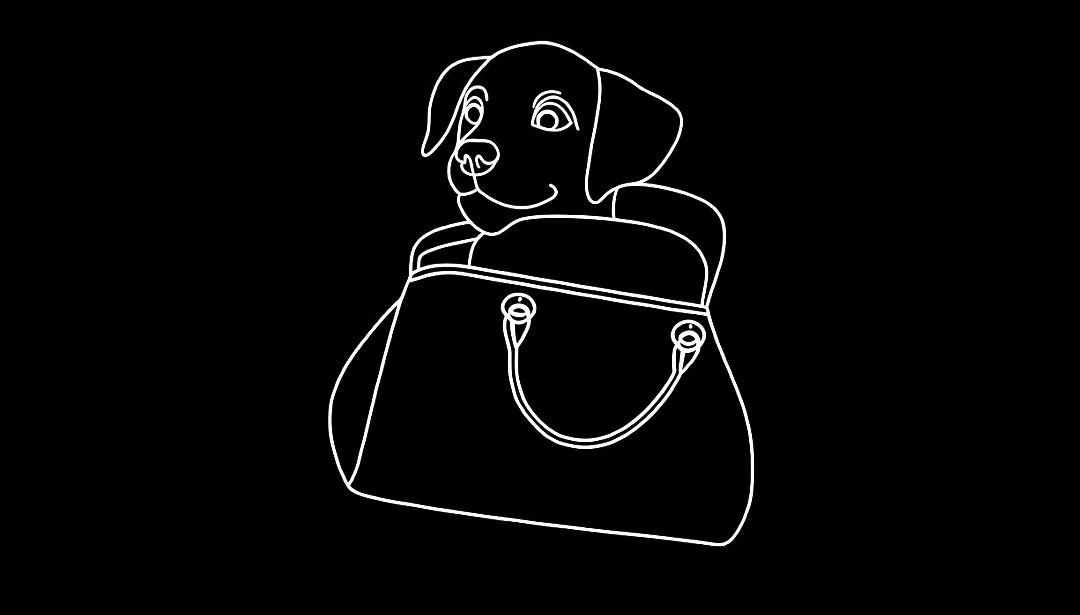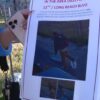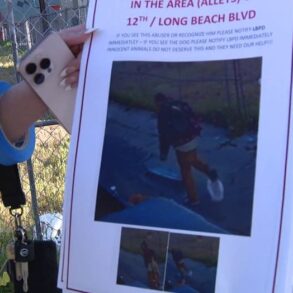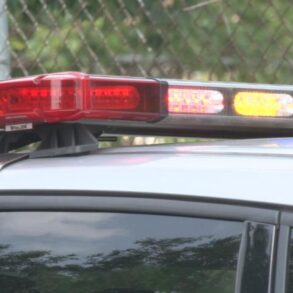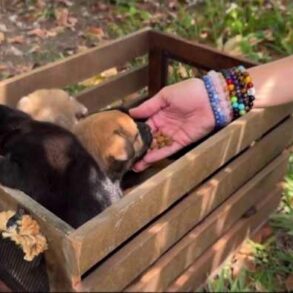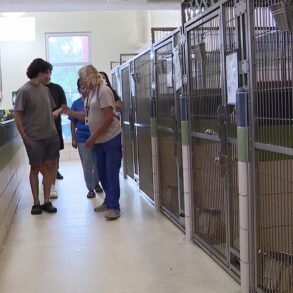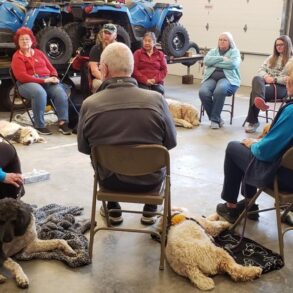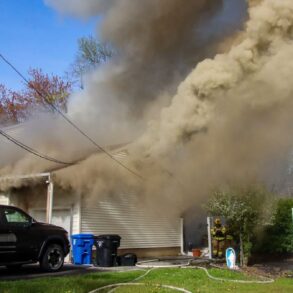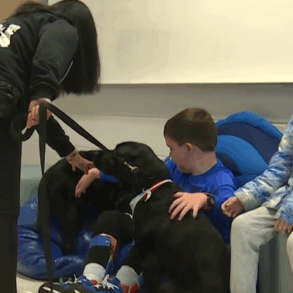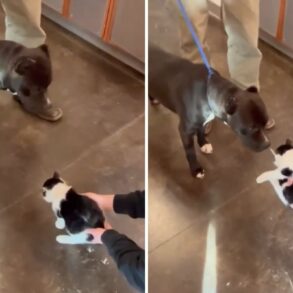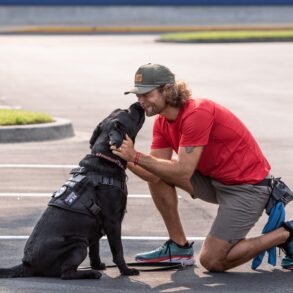Earlier this month Marlee Monahan buried a handful of jars under the mulch around a small garden area at the University of Hawaiʻi’s Urban Garden Center on Oʻahu.
Some of the jars are empty, and others contain several coconut rhinoceros beetle larvae.
Monahan, a dog handler for the Coconut Rhinoceros Beetle Response, set up a quick training session for 3-year-old Penny, a Labrador retriever and invasive species detection dog.
The jars have lids poked with small holes so the scent of the larvae can escape. The empty jars train Penny to focus on the CRB larvae, rather than the jars.
Coconut rhinoceros beetles, one of the top invasive species threats in Hawaiʻi, are often found in decaying green matter like mulch.
Penny, energetic and motivated by the food rewards she’ll get if she finds the beetles, is ready to find them.
“Alright, Penny, you wanna do some work?” Monahan asks Penny, who immediately tugs on her leash. “I’ll take that as a yes. All right, Penny — find it.”

Mark Ladao
/
HPR
The training session didn’t appear to be particularly difficult for Penny, who found the two jars with CRB larvae in them in just a few minutes.
After she found the first one, she sat down next to the patch of mulch and looked at Monahan.
That’s the signal.
“Yes, good girl! Good job,” Monahan said.
The pair were training for a four-day trip to Kona to search for the beetles discovered at and near the Ellison Onizuka Kona International Airport for the first time last month.
CRB eat and kill primarily palm trees, but are also known to attack other plants like taro, banana and even pineapple.
About 25 miles north of the airport, CRB were found in the Waikaloa area in 2023, marking the first time the beetle has ever been detected on Hawaiʻi Island.
Finding another batch of them on the island is concerning, but at such low numbers, there’s still an opportunity to manage their population.
Monahan and others say dogs help because they’re better and faster than entire teams of people at finding pest species in low numbers.
“They really shine where there is a lot of material to search through, and we just don’t have the time or resources to do that,” Monahan said. “They can pinpoint where they’re hiding, and then we can target that area specifically with way fewer resources involved.”
A precedent for using dogs to find and keep out pests
About 120 are being used throughout New Zealand, which has a well-regarded biosecurity program that Hawaiʻi officials have recently shown an interest in emulating.
It’s not entirely clear how many dogs are being used in Hawaiʻi for invasive species detection, but some estimate more than a dozen between various organizations and state and federal agencies.




Office of Gov. Josh Green
The U.S. Department of Agriculture has about half a dozen, and others are being used by the state Department of Agriculture and the Department of Land and Natural Resources.
It appears that government detection dogs are more focused on ports. The state DOA’s dogs work out of Honolulu’s Daniel K. Inouye International Airport to find invasive reptiles like the brown tree snake.
The snake isn’t a problem in Hawaiʻi, but officials say that without a proactive effort to keep it away, it could easily become established in the state — and cause billions of dollars of damage to the local economy.
The CRB Response has two dogs for the detection of coconut rhinoceros beetles, and the Maui Invasive Species Committee uses its dog to sniff out invasive little fire ants. MISC and other organizations focus on sniffing out invasive species in the field, rather than at ports.
Freddie, like Penny, is a 3-year-old Labrador retriever, and MISC’s first detector dog. Trisha Dillenburg, Freddie’s handler, said he was able to detect LFA at an 11-acre property where a “stinging ant” was reported.
“He could tell me exactly where to survey when I had this huge area and had no idea where to start,” Dillenburg said.
Detecting CRB on Kauaʻi
The Conservation Dogs of Hawaiʻi has been looking for volunteers with dogs on Kauaʻi that can be trained to sniff out CRB before the pests become established on the island.
CRB are widespread on Oʻahu, but they were discovered in 2023 for the first time not just on Hawaiʻi Island but also on Kauaʻi and Maui, so there’s still an opportunity to control them on those islands before they become established.
“Because Kauaʻi is still in an earlier stage than Oʻahu, the hope is that dogs could help mitigate the damage. We don’t know exactly how widespread CRB is on Kauaʻi, but it’s worth trying this effort with dogs because they are able to find targets that are not visible to the human eye,” said Kyoko Johnson, the group’s founder.
Last year it held a successful pilot program to see if dogs could be used to search for CRB in the field on Kauaʻi, and for the first part of this year had been looking to start a volunteer group of owners and dogs.
Johnson said she had difficulties finding qualified volunteers and dogs, who usually need to be motivated by toys or food and must be able to physically handle the work.
But after a two-week advertising blitz on local radio, she was able to find and screen three volunteers and four dogs, who are ready to start training in early May.
Some other organizations also want to add more dogs, although that progress is on hold for some.
Last month the CRB Response said it was supposed to receive another USDA-trained detector dog in January to replace one of its older dogs who was scheduled to retire soon, but that’s been delayed.
It’s not clear if that’s related to the Trump administration’s cuts to the federal government, but that new dog might not arrive until next year.
Detector dogs do have their limitations. They’ve been described as additional “employees” that can only work certain hours a day, and there are associated costs with keeping them healthy and trained.
But those who advocate for more dogs say they’re worth the price.
“I think everybody in the conservation field knows that trying to eradicate and establish species costs a lot more money and effort than preventing it,” Johnson said, adding, “ In other areas that have a strong biosecurity framework, they use detector dogs.”
This post was originally published on this site be sure to check out more of their content.
